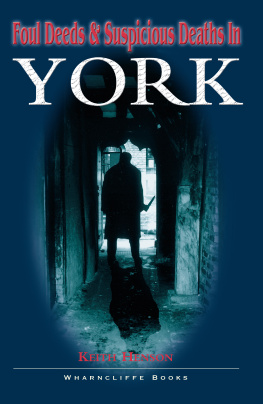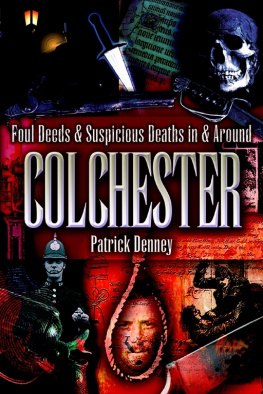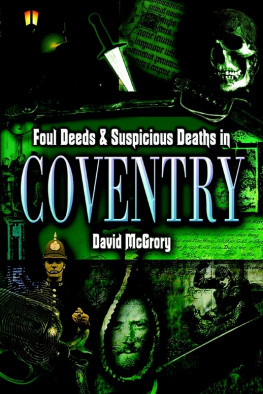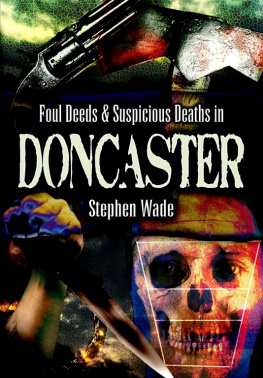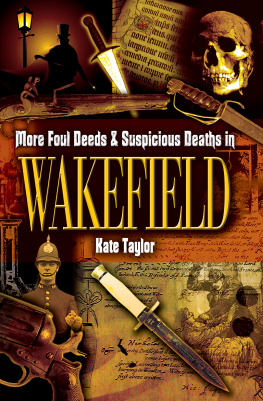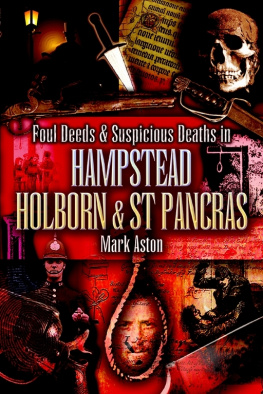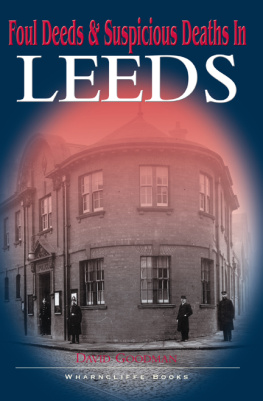FOUL DEEDS AND SUSPICIOUS DEATHS Series
Foul Deeds and Suspicious Deaths series explores in detail crimes of passion, brutal
murders, grisly deeds and foul misdemeanours. From Victorian street crime, to more
modern murder where passion, jealousy, or social depravation brought unexpected
violence to those involved. From mysterious death to murder and manslaughter, the
books are a fascinating insight into not only those whose lives are forever captured by
the suffering they endured, but also into the society that moulded and shaped their
lives. Each book takes you on a journey into the darker and unknown side of the area.
Other titles in the series
Foul Deeds and Suspicious Deaths in Blackburn & Hyndburn, Stephen Greenhalgh
1 903425 18 2 . 9.99
Foul Deeds and Suspicious Deaths In and Around Chesterfield, Geoffrey Sadler
1 903425 30 1 . 9.99
Foul Deeds and Suspicious Deaths In Leeds,David Goodman
1 903425 08 5 . 9.99
Foul Deeds and Suspicious Deaths In Nottingham, Kevin Turton
1 903425 35 2 . 9.99
Foul Deeds and Suspicious Deaths In and Around Rotherham, Kevin Turton
1 903425 27 1 . 9.99
Foul Deeds and Suspicious Deaths Around The Tees, Maureen Anderson
1 903425 26 3 . 9.99
Foul Deeds and Suspicious Deaths In Wakefield, Kate Taylor
1 903425 07 7 . 9.99
More Foul Deeds and Suspicious Deaths In Wakefield, Kate Taylor
1 903425 48 4 . 9.99
Foul Deeds and Suspicious Deaths In York, Keith Henson
1 903425 33 6 . 9.99
Foul Deeds & Suspicious Deaths on the Yorkshire Coast, Alan Whitworth
1 903425 01 8 . 9.99
Other Local Books
The Making of The West Yorkshire Landscape, Anthony Silson
1 903425 31 x . 9.99
Trams Around Dewsbury & Wakefield, Norman Ellis
1 903425 40 9 . 9.99
Please contact us via any of the methods below for more information or a catalogue.
WHARNCLIFFE BOOKS
47 Church Street Barnsley South Yorkshire S70 2AS
Tel: 01226 734555 734222 Fax: 01226 734438
E-mail:

First Published in 2004 by
Wharncliffe Books
an imprint of
Pen and Sword Books Limited,
47 Church Street, Barnsley,
South Yorkshire. S70 2AS
Copyright Keith Henson, 2004
For up-to-date information on other titles produced under the
Wharncliffe imprint, please telephone or write to:
Wharncliffe Books
FREEPOST
47 Church Street
Barnsley
South Yorkshire S70 2BR
Telephone (24 hours): 01226 - 734555
ISBN: 1-903425-54-9
PRINT ISBN: 9781903425541
PDF ISBN: 9781783037759
EPUB ISBN: 9781783037773
PRC ISBN: 9781783037766
All rights reserved. No part of this publication may be
reproduced, stored in a retrieval system, or transmitted, in
any form or by any means, electronic, mechanical,
photocopying, recording or otherwise, without the prior
permission in writing of the publishers.
This book is sold subject to the condition that it shall not,
by way of trade or otherwise, be lent, resold, hired out or
otherwise circulated without the publishers prior consent in
any form of binding or cover other than that in which it is
published and without a similar condition including this
condition being imposed on the subsequent purchaser.
A CIP catalogue record of this book is available from the
British Library
Cover illustrations: (front) The Noose Oleg Volk
(back) The author
Cover design: Jonathan Wilkinson
Printed in the United Kingdom by
CPI UK
Contents
Introduction
Foul. adjective offensive, loathsome, stinking; dirty; soiled.
(Oxford English Dictionary)
J ust what constitutes a foul deed largely depends upon your perspective of the event. What is abhorrent to one person does not always have the same effect on another. Even in cases of murder, your views can be forced down a sympathetic path for the murderer once the reasons for their actions are known.
What can be said of both is that we, as human beings, are attracted to them. It is the moth and the flame; the thing that hurts us, scares us, even threatens our life is a magnet to our curiosity. And as we ponder upon the brutality of others and the reason for death, we count our blessings and think, there but for the grace of God go I.
At least after reading this book, you will know to avoid drink, water, arsenic, arguments, guns, ash pits, creosote, pit ponies and small canons.

PC Brewer served in the Pontefract Police Force in the late nineteenth century until he retired to market his Indestructable sock. Wakefield MDC Cultural Services.
C HAPTER 1
In Mr Baileys Words
Normanton: 1853
I n 1958, a local solicitor began clearing the private papers of a house in Normanton. In amongst them was an account of two events in the village, written by Mr Christopher Bailey; one of a murder that had taken place two years after his birth in 1828 and a suspicious death in 1853.
Though the death of William Longthorn had been only a story to Christopher Bailey, his interest was heightened when in 1843 the murdered mans younger brother called at his parents hostelry, the Black Swan Inn, asking to be shown the site of his brothers death. Bailey took him to the scene of the murder and from there to Normanton churchyard where a stone, erected by the people of the village, read:
In memory of William Longthorn of Barnby Moor, near Pocklington, who was murdered in the field called Dole Close in the township of Syndale, October 17th 1828.
My mother, wrote Bailey, who saw the murdered man, said he very much resembled him.
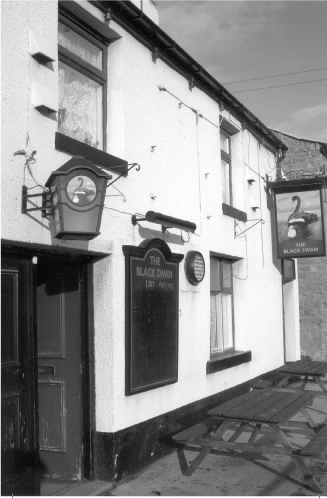
The Black Swan Public House. The author
Having left grammar school, Bailey worked briefly at Shilitos Farm near Altofts, eventually joining the railway staff at Normanton in 1851, where he worked in the clearinghouse. Apart from newspaper reports and court records, documented eye witness accounts of suspicious deaths and foul deeds are rare indeed, and so well let Christopher Bailey give his version of what unfolded on that spring evening of 1853:
On April 29th, there arrived at the railway station a young lady dressed in deep mourning. She had as luggage a small, dark green painted box, on the lid of which was nailed an address card with the owners name as follows: Miss Cocking Passenger. No destination was shown. She left the box in my charge and it remained on the platform until night, when, as she had not returned it was taken to the Station Masters Office. (That being the place then for luggage left in such circumstances.) On the following day (Saturday) as I was going to dinner, I met the then Village Constable Mr William Heptinstall, shoemaker, who told me that a young lady dressed in mourning had been found drowned in the vicarage pond by Mr Joseph Righton, the vicars manservant. It was believed to be Miss Cocking who had lived previously for some years in the vicars (Mr Mason) service, as a governess. I then informed the constable about the box, which was unclaimed at the railway station and left no doubt as to who the young lady was.
An inquest was, of course, held on the body by Thomas Taylor Esq., then Deputy Coroner, and I attended as a witness. It was stated that Miss Cocking had been living in the family of a gentleman named Kaye, at or not far from Bretton. She had been to see her parents at Market Rasen in Lincolnshire and was returning to Mr Kayes, breaking her journey apparently at Normanton to call and see her old master and mistress at the vicarage, who I believe, were not at home at the time
Next page

